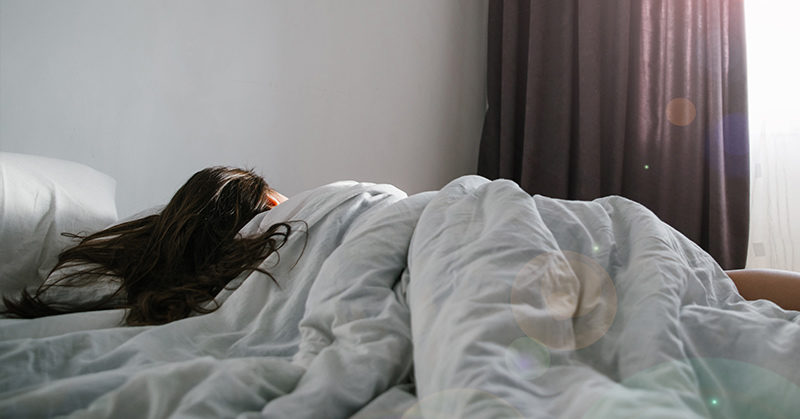Picture this scenario: It’s a hot night. You’re tossing and turning, the stifling temperatures making it impossible to fall asleep. Despite the heat, however, there’s one thing you can’t part with: your blanket. Even though it’s ninety degrees in your room, you just can’t go to sleep without a blanket.
Many of us have been in a similar situation. Despite the high temperatures, we still have this instinctual need to have a covering while we sleep. But why is that?
It turns out, science has an explanation for why, no matter how hot it gets, we just can’t sleep without a blanket.
Why We Can’t Sleep Without a Blanket
Most people sleep with some kind of covering. A 2002 paper by Carol Worthman and Melissa Melby of Emory University studied sleeping arrangements around the world. They found that the only people who sleep with no covering are nomadic foragers. Everyone else prefers to cover themselves up with something, whether that’s a cotton sheet or some form of plant matter [1].
According to scientists, there is both a behavioural component and a psychological component for why we need a blanket (or at least some type of covering) to fall asleep. Within those two components, there appears to be three main reasons why we can’t sleep without a blanket:
Temperature Regulation
Sleep consultant Anna McGinn explains that using a blanket helps us deal with our lower nightly body temperature. She says that our circadian rhythm, which is the main driver behind sleep, begins to lower our core body temperature starting at two in the afternoon.
This temperature continues to drop gradually throughout the evening and night [2].
The purpose of this temperature drop is to help you eventually fall asleep. Essentially, when your body is more heated, you will feel more alert. When your body cools down, you feel sleepier. This is why many sleep experts recommend keeping the temperature of your room lower at night- to help you sleep [3].
During the day, your body does an excellent job of regulating your body temperature. At night, however, things begin to change. The first few hours of sleep your body temperature will continue to drop, but in the second half of the night, when you’re experiencing rapid eye movement (REM) sleep, your body loses its ability to thermoregulate [4].
Essentially, you become more like a reptile. As mammals, we can regulate our body temperatures through sweating and shivering. Reptiles can’t do that, so instead, they use external sources to warm them up or cool them down. This is why you often see lizards sitting in a patch of sun.
During REM sleep, we lose our ability to shiver. For this reason, we look for an external source to keep us warm. This holds true in hot climates, because even there the temperatures drop at night. Just as we’re entering REM sleep, the temperature is reaching its coolest point [5].
They Keep Us Calm
Loss of temperature control is not the only thing that happens during REM sleep. Studies show that during the REM periods of sleep, our bodies drastically lower their levels of serotonin. Serotonin, also known as “the happy chemical”, promotes feelings of calm, happiness, and wellbeing [6]. Blankets, however, appear to increase our serotonin levels.
Several studies have shown that sleeping with a weighted blanket in particular can increase the amount of serotonin your brain is producing [7].
“The firm pressure of the blankets activates the nervous system and releases serotonin – a chemical in the body that helps us feel calm and also helps to release melatonin, which is a natural sleep hormone that helps prepare us to sleep,” McGinn said [2].
Conditioning
The third and final reason why you can’t sleep without a blanket is simply because it’s what you’ve always done. If your parents put you to bed with a blanket, you will likely continue to do so as an adult.
Babies are not as good at thermoregulating as adults. For this reason, your parents wrapped you in a blanket when you were an infant to keep you warm at night [8]. This habit has probably made you associate a blanket with sleep. Without it, something feels missing from your nightly routine.
“We’re cueing to our body (and) cuing to our brain that it’s time to go to sleep because you got the blanket on,” says McGinn [2].
What To Do If You’re a Hot Sleeper
If you’re someone who often finds they get very hot at night, but you still can’t sleep without a blanket, McGinn has some advice for you:
- Keep the temperature of your room cooler. The ideal sleep temperature is between 19 and 23 degrees celsius (66 to 73 degrees fahrenheit).
- Don’t sleep naked. Instead, choose clothes and blankets made of lighter, breathable fabrics. Good fabrics for this are flax, cotton, or bamboo.
- Use light-colored blankets, which absorb less light.
- Consider using a cooling pad or blanket.
Of course, many other factors can affect whether or not you get a good night’s sleep, like your sleeping position. But don’t worry, science can fix that, too.
McGinn admits that finding what works for you can be a challenge. It is important, though, that everyone figures out the best sleeping arrangements for them, so they can have a good nights rest [2].
- https://anthropology.emory.edu/home/documents/worthman-lab/Ecology%20of%20Human%20sleep.pdf
- https://www.ctvnews.ca/lifestyle/why-we-need-blankets-to-sleep-even-when-it-s-hot-1.4629752
- https://pubmed.ncbi.nlm.nih.gov/18192289/
- https://www.ncbi.nlm.nih.gov/pmc/articles/PMC5573803/#:~:text=Numerous%20data%20show%20a%20reciprocal,exposure%2C%20suppresses%20REM%20sleep%20occurrence.
- https://watermark.silverchair.com/100503.pdf
- https://www.jneurosci.org/content/33/6/2555#:~:text=Serotonin%20levels%20were%20at%20125,3A%2CB).
- https://www.ptsdjournal.com/posts/sleeping-with-weighted-blanket-helps-insomnia-and-anxiety-study-finds/
- https://www.urmc.rochester.edu/encyclopedia/content.aspx?contenttypeid=90&contentid=P02425

